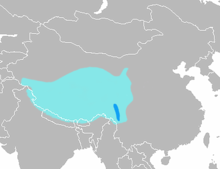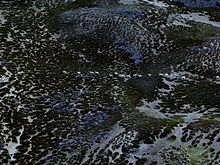Bharal
| Bharal | |
|---|---|

| |
| Male bharal in Spiti Valley
| |

| |
| Female bharal in North Sikkim
| |
| Scientific classification | |
| Domain: | Eukaryota |
| Kingdom: | Animalia |
| Phylum: | Chordata |
| Class: | Mammalia |
| Order: | Artiodactyla |
| Family: | Bovidae |
| Subfamily: | Caprinae |
| Tribe: | Caprini
|
| Genus: | Pseudois Hodgson, 1846 |
| Species: | P. nayaur
|
| Binomial name | |
| Pseudois nayaur (Hodgson, 1833)
| |

| |
| Distribution of blue sheep; dwarf blue sheep range in darker blue | |
| Synonyms | |
|
Pseudois schaeferi Haltenorth, 1963 Pseudois nayaur schaeferi | |
The bharal (Pseudois nayaur), also called the blue sheep, is a
Its native names include yanyang (岩羊) in
The bharal was also the focus of George Schaller and Peter Matthiessen's expedition to Nepal in 1973. Their personal experiences are well documented by Matthiessen in his book, The Snow Leopard. The bharal is a major prey of the snow leopard.Description
These medium-sized caprids are 115 to 165 cm (45 to 65 in) long along the head-and-body, with a tail of 10 to 20 cm (3.9 to 7.9 in). They stand 69 to 91 cm (27 to 36 in) high at the shoulder. Body mass can range from 35 to 75 kg (77 to 165 lb). Males are slightly larger than females. Dense coat is slate grey in colour, sometimes with a bluish sheen. The underparts and backs of the legs are white, while the chest and fronts of the legs are black. Separating the grey back and white belly is a charcoal-colored stripe. The ears are small, and the bridge of the nose is dark. The horns are found in both sexes and are ridged on the upper surface. In males, they grow upwards, then turn sideways and curve backward, looking somewhat like an upside-down mustache. They may grow to a length of 80 cm (31 in). In females, the horns are much shorter and straighter, growing up to 20 cm (7.9 in) long.[5][6]
Taxonomy and evolution
- Chinese blue sheep, Pseudois nayaur szechuanensis
- Himalayan blue sheep, P. n. nayaur
- Helan Shan blue sheep, P. n. ssp.
Dwarf blue sheep

The dwarf blue sheep or dwarf bharal (formerly described as Pseudois schaeferi), also known as rong-na in
However, a 2012 genetic analysis of Chinese bharal found no indication that it was either a distinct species or subspecies, instead finding to be a morphologically distinct variant of P. n. szechuanensis. The American Society of Mammalogists also follows these results, considering P. schaeferi to be conspecific with P. nayaur.[3][7]
Behaviour and ecology



Bharal are active throughout the day, alternating between feeding and resting on the grassy mountain slopes. Due to their excellent camouflage and the absence of cover in their environment, bharal remain motionless when approached. Once they have been noticed, however, they scamper up to the precipitous cliffs, where they once again freeze, using camouflage to blend into the rock face. Population densities in Nepal were found to be 0.9–2.7 animals per km2, increasing to a maximum of 10 animals in the winter, as herds congregate in valleys.[5] Bharal are mainly grazers, but during times of scarcity of grass, they switch to browsers, eating herbs and shrubs.
Rutting behaviour
The rutting of the bharal starts towards late November and continues until mid-January. During the rut, male bharal use multiple strategies for mating, namely tending, blocking, and coursing.[11] Their lambs are born in late June and July.[citation needed]
Threats
The bharal is categorised as
Relationship with humans
Many Buddhist monasteries protect the bharal found around them, but lately,[
References
- ^ . Retrieved 19 November 2021.
- JSTOR 3503993.
- ^ a b "Pseudois nayaur (Hodgson, 1833)". ASM Mammal Diversity Database. American Society of Mammalogists. Retrieved 2021-08-28.
- ^ Lydekker, R. (1900). The great and small game of India, Burma and Tibet, p 93,
- ^ a b c Bharal, Himalayan blue sheep Archived 2015-04-06 at the Wayback Machine. Ultimateungulate.com. Retrieved on 2012-08-23.
- ISBN 0691099847.
- ^ S2CID 17673293.
- . Retrieved 19 January 2024.
- S2CID 1486413.
- .
- S2CID 7587862.
Further reading
- Namgail, Tsewang; Fox, Joseph L.; Bhatnagar, Yash Veer (2004). "Habitat segregation between sympatric Tibetan argali Ovis ammon hodgsoni and blue sheep Pseudois nayaur in the Indian Trans-Himalaya". Journal of Zoology. 262: 57–63. S2CID 59067250.
- Namgail, T., van Wieren, S.E., Mishra, C. & Prins, H.H.T. (2010). Multi-spatial co-distribution of the endangered Ladakh urial and blue sheep in the arid Trans-Himalayan Mountains. Journal of Arid Environments, 74:1162-1169.
- Namgail, T., Mishra, C., de Jong, C. B., van Wieren, S.E. & Prins, H.H.T. (2009). Effects of herbivore species richness on blue sheep niche dynamics and distribution in the Indian Trans-Himalaya. Diversity and Distributions, 15:940-947.
- Namgail, Tsewang (December 2001). Habitat selection and ecological separation between sympatric Tibetan argali and blue sheep in northern India (PDF) (Thesis). University of Tromso. hdl:10535/3567.
- Namgail, Tsewang (January 2006). "Winter Habitat Partitioning between Asiatic Ibex and Blue Sheep in Ladakh, Northern India". Journal of Mountain Ecology. 8: 7–13. S2CID 54699112.
- Shrestha, Rinjan; Wegge, PER (2008). "Wild sheep and livestock in Nepal Trans-Himalaya: Coexistence or competition?". Environmental Conservation. 35 (2): 125–136. S2CID 58913300.
- Shrestha, Rinjan; Wegge, Per (June 2008). "Habitat relationships between wild and domestic ungulates in Nepalese Trans-Himalaya". Journal of Arid Environments. 72 (6): 914–925. .
- Shrestha, R., Wegge, P. & Koirala, R. A. (2005). Summer diets of wild and domestic ungulates in Nepal Himalaya. Journal of Zoology (London), 266: 111 – 119.
External links
 Media related to Pseudois nayaur at Wikimedia Commons
Media related to Pseudois nayaur at Wikimedia Commons- Photos and further information
- Bharal at Animal Diversity Web

